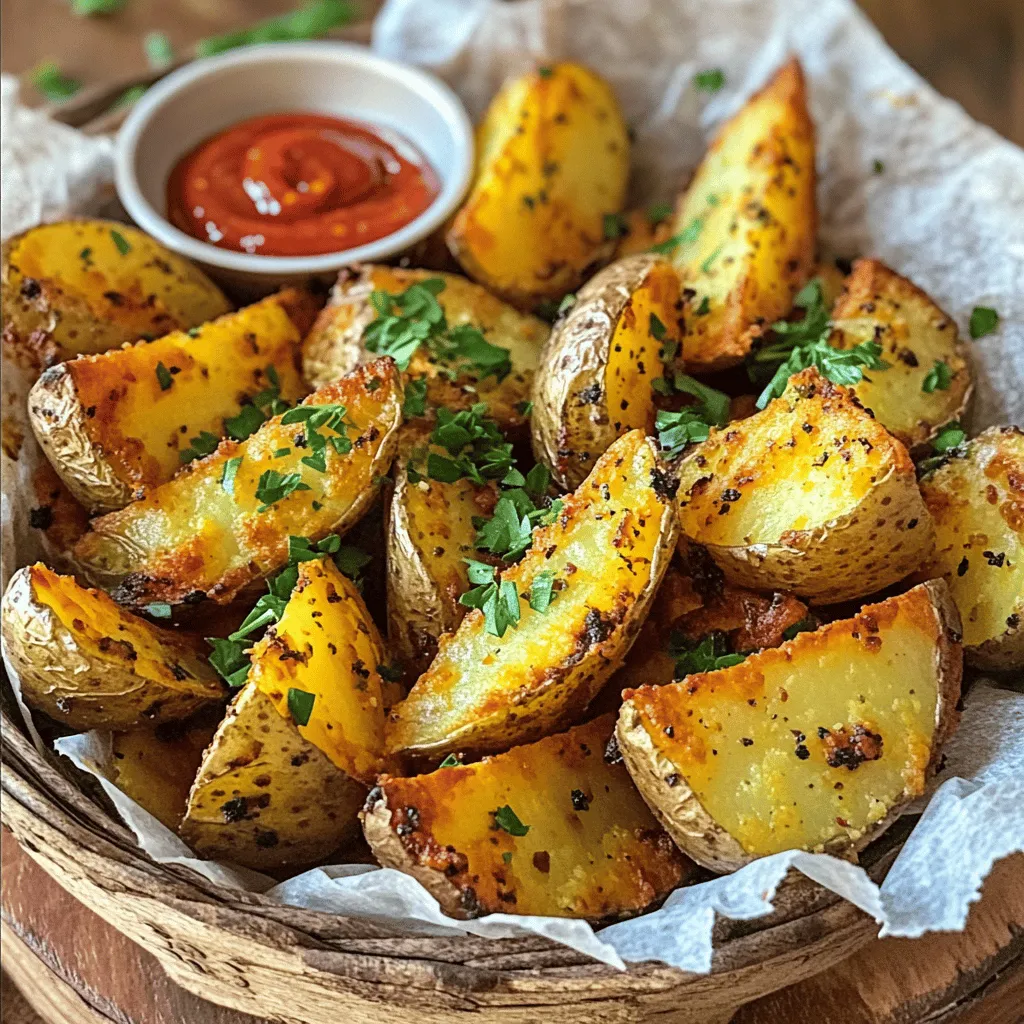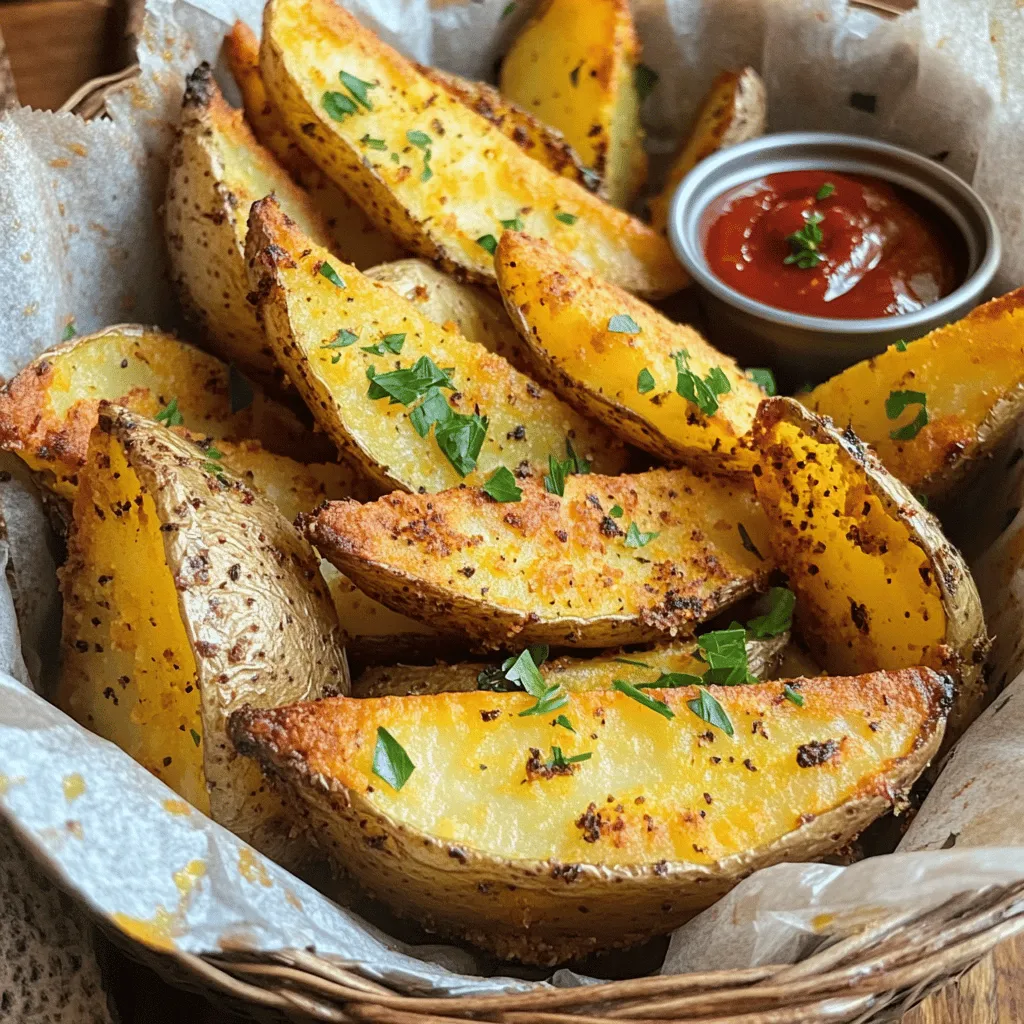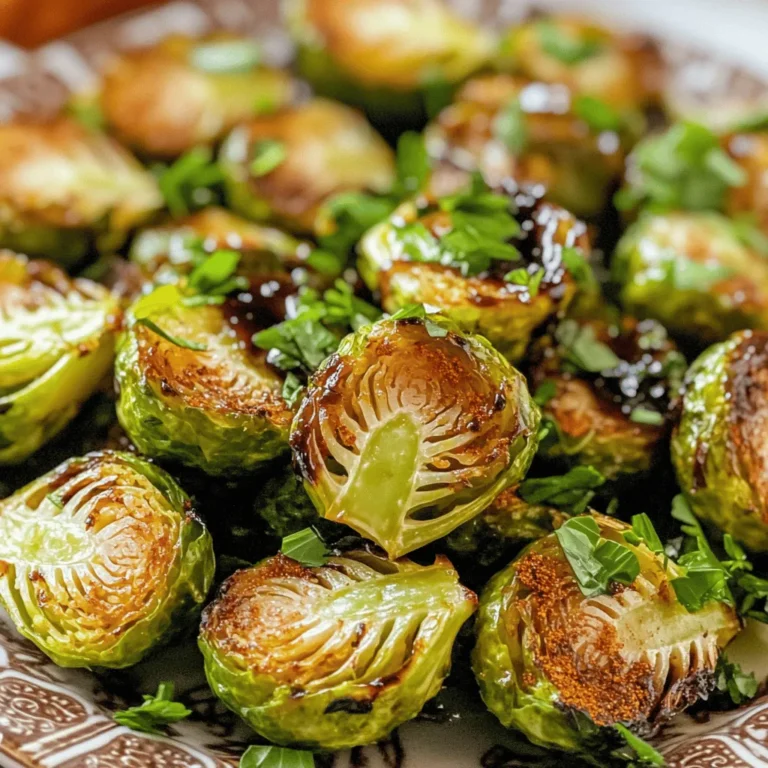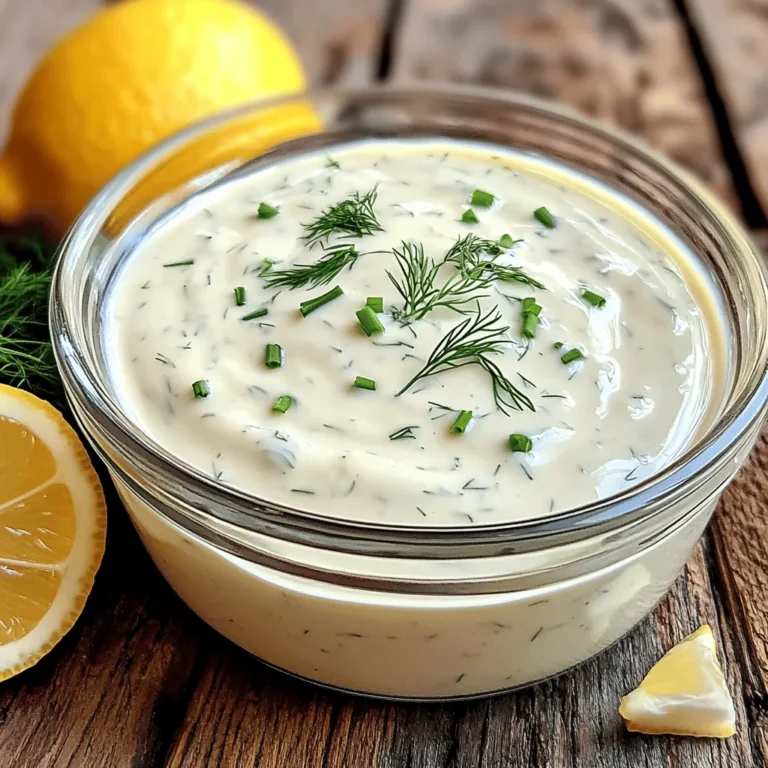Crispy Potato Wedges Simple and Flavorful Recipe

Are you ready to elevate your snack game? My crispy potato wedges are simple to make and bursting with flavor. With just a few ingredients, you’ll create golden, crunchy bites that your friends and family will love. Whether you’re watching a game or enjoying a cozy night in, these wedges are the perfect addition to your table. Let’s dive into the easy recipe and get cooking!
Ingredients
Here’s what you need for crispy potato wedges.
– 4 large russet potatoes
– 3 tablespoons olive oil
– 1 teaspoon garlic powder
– 1 teaspoon onion powder
– 1 teaspoon smoked paprika
– 1/2 teaspoon cayenne pepper
– 1 teaspoon dried oregano
– Salt and freshly ground black pepper to taste
– Fresh parsley, finely chopped (for garnish)
These ingredients create amazing flavor and texture. The russet potatoes give you that fluffy inside and crispy outside. Olive oil helps in browning the wedges. Garlic powder and onion powder add depth. Smoked paprika brings warmth, while cayenne pepper adds a kick. Oregano gives a hint of earthiness. Use salt and pepper to enhance all these great flavors. Fresh parsley adds a lovely touch at the end.
Step-by-Step Instructions
Preparation Steps
– Preheat oven to 425°F (220°C).
– Wash and slice potatoes into wedges.
– Prepare seasoning blend.
First, I start by preheating my oven to 425°F (220°C). This high heat helps make the wedges crispy. While the oven heats up, I wash the russet potatoes. I scrub them well but keep the skins on for texture. Next, I slice each potato in half lengthwise. Then, I quarter each half to create wedge shapes.
Now it’s time to prepare the seasoning blend. In a bowl, I mix together the olive oil, garlic powder, onion powder, smoked paprika, cayenne pepper, oregano, and a good pinch of salt and pepper. This blend gives the wedges a great flavor.
Cooking Steps
– Toss the potato wedges in the seasoning.
– Arrange on baking sheet and bake.
– Flip wedges halfway for even cooking.
Once I have the seasoning ready, I toss the potato wedges in it. I make sure every wedge gets coated. This step is key for flavor. Next, I arrange the seasoned wedges in a single layer on a baking sheet. I avoid overcrowding them; this helps them crisp up nicely.
I place the baking sheet in the oven and bake for 30 to 35 minutes. At the halfway point, I flip the wedges to ensure they brown evenly. When they turn golden brown, I know they are ready.
Final Touch
– Garnish and serve.
After baking, I take the wedges out of the oven and let them cool for a minute. I like to finish them off by garnishing with fresh parsley. This adds a nice pop of color and freshness. These crispy potato wedges are now ready to enjoy!
Tips & Tricks
Achieving Crispiness
To get crispy potato wedges, arrange them in a single layer. This allows the heat to circulate evenly around each wedge. If you stack them or crowd the pan, they steam instead of crisping. Flip the wedges halfway through cooking. This step helps both sides brown and crisp up perfectly.
Seasoning Adjustments
You can change the spice level to fit your taste. If you like heat, add more cayenne pepper. For milder flavor, use less. Try using different herbs, like rosemary or thyme, for a fresh twist. You can also experiment with curry powder or Italian seasoning.
Cooking Methods
Oven baking is great, but air frying is an excellent option too. Air fryers can make them even crispier while using less oil. If you prefer grilling, you can cook wedges on a grill for a smoky flavor. Just make sure to watch them closely to prevent burning.

Variations
Flavor Variations
You can take your crispy potato wedges to new heights. Here are two tasty ideas:
– Cheesy herb wedges: Add shredded cheese and fresh herbs. Try mixing in parmesan and thyme before baking. The cheese will melt and create a delightful crust.
– Spicy buffalo-style wedges: Toss the wedges in buffalo sauce after baking. This adds heat and flavor. Serve with blue cheese dressing for a cool counterbalance.
Dietary Modifications
If you have dietary needs, here are some easy swaps:
– Vegan alternatives: Use vegetable oil instead of olive oil. This keeps it plant-based. You can also skip cheese or use a vegan cheese if you try the cheesy variation.
– Gluten-free considerations: This recipe is naturally gluten-free. Just check your seasoning blends. Some spices may have additives with gluten.
Serving Suggestions
Pair your crispy potato wedges with fun dips and mains:
– Pairing with dips: Try serving with ketchup, ranch, or spicy mayo. These will enhance the flavor and make it more fun.
– Ideal mains to serve alongside: Crispy wedges pair nicely with grilled chicken or veggie burgers. They also work great with steak or a fresh salad.Enjoy!
Storage Info
Storing Leftovers
To keep your crispy potato wedges fresh, follow these tips:
– Refrigeration: Place the cooled wedges in an airtight container. They can last up to 3 days in the fridge. If you want optimal crispiness, store them without any sauce.
– Freezing: For longer storage, freeze the wedges. Place them in a single layer on a baking sheet. Once frozen, transfer them to a freezer bag. They can last for up to 2 months.
Reheating Suggestions
To enjoy your crispy potato wedges again, use these methods:
– Restoring Crispiness: The best way to make them crispy is to use the oven. Preheat your oven to 400°F (200°C). Spread the wedges on a baking sheet and bake for 10-15 minutes. They will crisp up beautifully.
– Microwave vs. Oven: The microwave is quick but may make the wedges soft. If you’re short on time, use it for about 1 minute. However, if you want that crunchy texture, the oven is the way to go.
FAQs
How long do crispy potato wedges last?
Crispy potato wedges can last in the fridge for about 3 to 5 days. Store them in an airtight container. If you want to keep them longer, freeze them. Frozen wedges can last up to 3 months. Just be sure to let them cool completely before freezing.
Can I use other types of potatoes?
Yes, you can use different types of potatoes! Russet potatoes are great for their crispiness, but Yukon Golds or red potatoes work well too. Each type has its own flavor and texture, so feel free to experiment.
How do I make potato wedges crispier?
To make potato wedges crispier, follow these tips:
– Cut the wedges evenly for uniform cooking.
– Soak the potato wedges in cold water for 30 minutes. This helps remove excess starch.
– Use enough oil to coat them well but not drown them.
– Bake them in a single layer without overcrowding.
Can I make these wedges ahead of time?
You can prepare the wedges ahead of time. Cut and season them, then store them in the fridge for up to 24 hours. When ready to cook, pop them in the oven. If you want to freeze them, freeze the raw wedges. Just remember to let them thaw before cooking.
What dips go well with crispy potato wedges?
Popular dips for crispy potato wedges include:
– Ketchup
– Ranch dressing
– Spicy mayo
– Garlic aioli
– Sour cream with chives
These dips enhance the flavor and make each bite even better!
This blog post guided you through making crispy potato wedges, from the right ingredients to preparing and cooking methods. Remember, using a single layer on the baking sheet is key for crispiness. You can also tweak the seasonings for your personal taste. Try different potatoes or cooking methods, and don’t forget about delicious dips. Enjoy your tasty wedges as a perfect snack or side dish. Keep exploring and experimenting with flavors!



. 1. Heat olive oil in a large skillet over medium heat. 2. Add finely chopped red onion to the skillet. 3. Sauté the onion for 2-3 minutes until it becomes soft. 4. Now, add diced red and green bell peppers to the skillet. 5. Cook for 3-4 minutes until the peppers soften. 6. Stir in corn kernels and black beans. 7. Season with ground cumin, smoked paprika, garlic powder, salt, and pepper. 8. Mix well and cook for 5 more minutes until hot. 1. Heat another skillet over medium heat. 2. Place a tortilla in the skillet and sprinkle ¼ cup of cheese on it. 3. Layer ½ cup of the veggie mixture over the cheese. 4. Top with another ¼ cup of cheese for extra flavor. 5. Fold the tortilla in half, covering the filling. 6. Cook for 3-4 minutes until golden brown on one side. 7. Flip the quesadilla gently using a spatula. 8. Cook for another 3-4 minutes until crispy and cheese melts. - Keep the heat at medium for a crispy texture. - Use a spatula to flip the quesadilla easily. - Check for doneness by ensuring both sides are golden brown. These simple steps make it easy to create loaded veggie quesadillas at home. For the full recipe, refer to the recipe section above. Enjoy the process! Choosing the right cheese is key. I love a mix of cheddar and mozzarella. This mix melts well and adds great flavor. You want the cheese to stretch and pull when you take a bite. Balancing spices and seasonings is also important. Start with the basics like salt and pepper. Then, add spices like cumin and smoked paprika. Adjust them to fit your taste. A little heat can come from red pepper flakes if you like it spicy. Day-to-day storage tips help keep your quesadillas fresh. Place leftovers in an airtight container. Keep them in the fridge for up to three days. You can also wrap them tightly in foil or plastic wrap. Reheating suggestions for best flavor include using the oven or skillet. For the oven, preheat to 350°F. Heat the quesadillas for about 10 minutes. In a skillet, cook them over medium heat. This method keeps them crispy and delicious. Plating ideas can make your meal pop. Arrange the quesadillas in a fan shape on a colorful plate. This makes them look fun and inviting. Adding colorful garnishes like fresh cilantro adds a nice touch. You can also sprinkle some diced tomatoes or avocado on top. These small changes make your meal look gourmet. Enjoy your loaded veggie quesadillas! For the full recipe, check out the Loaded Veggie Quesadillas 🥑 section. {{image_4}} You can make loaded veggie quesadillas even more fun. Here are some easy ideas. Want some extra protein? You can add grilled chicken or tofu. Just cook them first, then slice and add to your quesadilla mix. If you like seafood, try shrimp. Cook them quickly and toss them in for a tasty twist. Spices can change the game. Try different spices like chili powder or oregano. They add depth and warmth. You can also add sauces or marinades. A dash of hot sauce or a sprinkle of lime juice can elevate your quesadillas. Need gluten-free options? Use gluten-free tortillas. They work great and taste just as good. If you're vegan, swap out the cheese for a plant-based version. There are many tasty dairy-free cheeses out there that melt well. You can find the full recipe for loaded veggie quesadillas to get started on these variations. To keep your uncooked quesadillas fresh, wrap them tightly in plastic wrap. This keeps out moisture and air. You can also place them in an airtight container. If you want to freeze them, stack the quesadillas with parchment paper in between. This prevents them from sticking together. Uncooked quesadillas can stay in the freezer for up to three months. After cooking, let the quesadillas cool completely. Then, wrap them in foil or place them in a container. Store them in the fridge for up to four days. I find they taste best within the first two days. If you notice any odd smell or mold, it’s best to toss them. To reheat, use an oven or a skillet. For the oven, preheat to 350°F (175°C). Place the quesadilla on a baking sheet and heat for about 10 minutes. If using a skillet, add a little oil and heat over medium heat for about 3-4 minutes on each side. Leftover quesadillas can also become a fun breakfast. Chop them up and add them to scrambled eggs for a tasty twist. For more ideas, check out the Full Recipe. Making loaded veggie quesadillas is quick and easy. It takes about 10 minutes to prep. Cooking them takes around 15 minutes. In total, you can make them in about 25 minutes. This makes them a great choice for busy days or quick meals. Yes, you can prep loaded veggie quesadillas in advance. To do this, cook the veggie mixture and let it cool. Then, assemble the quesadillas but do not cook them. Store them in an airtight container in the fridge for up to two days. You can also freeze them for a month. When ready to eat, just cook them straight from the fridge or freezer. This makes meal prepping super easy! You can mix and match many veggies in quesadillas. Some great options include: - Spinach or kale for a green boost - Mushrooms for a savory taste - Zucchini or squash for extra texture - Jalapeños for a spicy kick - Tomatoes for freshness Feel free to get creative! Each veggie adds its own flavor and texture. You can make quesadillas that fit your taste perfectly. For more ideas, check out the Full Recipe. These loaded veggie quesadillas are fun and easy to make. We explored essential ingredients like black beans, bell peppers, and corn. I’ve shared tips for perfect texture, storing leftovers, and creative garnishes. Remember, you can customize them with protein or spices to suit your taste. In the end, these quesadillas are more than just food; they bring flavor and joy. Enjoy making them your own!](https://goldendishy.com/wp-content/uploads/2025/06/a7c52493-2108-4a2f-8f90-ee80e7df7b2a-768x768.webp)



